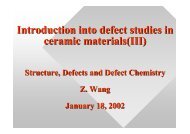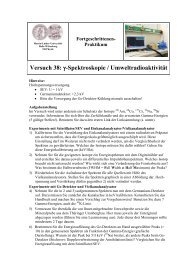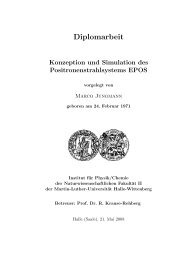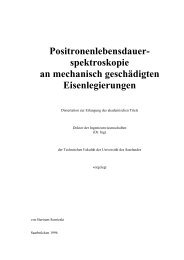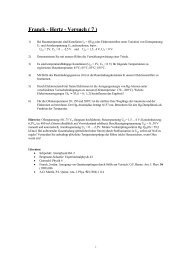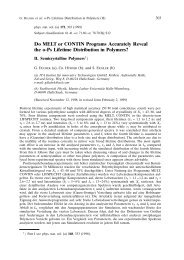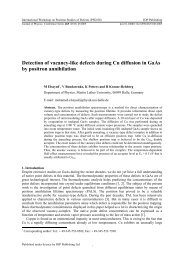Download PDF-File - Positron Annihilation in Halle
Download PDF-File - Positron Annihilation in Halle
Download PDF-File - Positron Annihilation in Halle
Create successful ePaper yourself
Turn your PDF publications into a flip-book with our unique Google optimized e-Paper software.
phys. stat. sol. (a), 1–8 (2004) / DOI 10.1002/pssa.200306819<br />
Defects <strong>in</strong> silicon plastically deformed at room temperature<br />
H. S. Leipner *; 1 , Z. Wang 2 ,H.Gu 1 , V. V. Mikhnovich Jr. 1 , V. Bondarenko 3 ,<br />
R. Krause-Rehberg 3 , J.-L. Demenet 4 , and J. Rabier 4<br />
1 Interdiszipl<strong>in</strong>åres Zentrum fçr Materialwissenschaften, Hoher Weg 8, Mart<strong>in</strong>-Luther-Universitåt,<br />
06120 <strong>Halle</strong>, Germany<br />
2 Department of Physics, Wuhan University, Wuhan 430072, P.R. Ch<strong>in</strong>a<br />
3 Fachbereich Physik, Friedemann-Bach-Platz 6, Mart<strong>in</strong>-Luther-Universitåt, 06108 <strong>Halle</strong>, Germany<br />
4 Laboratoire de M tallurgie Physique, UMR 6630, Universit<br />
86962 Futuroscope-Chasseneuil Cedex, France<br />
de Poitiers, SP2MI, BP 30179,<br />
Received 12 August 2003, revised 10 March 2004, accepted 7 April 2004<br />
Published onl<strong>in</strong>e 11 June 2004<br />
PACS 61.72.Ji, 61.72.Lk, 62.20.Fe, 78.70.Bj<br />
<strong>Positron</strong> trapp<strong>in</strong>g <strong>in</strong> silicon deformed under high-stress conditions at room temperature is compared to<br />
that <strong>in</strong> Si plastically deformed at higher temperatures. After room temperature deformation, thermally<br />
rather stable vacancy clusters appear. No evidence for positron capture <strong>in</strong> dislocations is found. In<br />
contrast, after high-temperature deformation, positrons are trapped <strong>in</strong> rather large vacancy clusters and<br />
<strong>in</strong> dislocations act<strong>in</strong>g as comb<strong>in</strong>ed positron traps. The specific features of positron trapp<strong>in</strong>g <strong>in</strong> silicon<br />
plastically deformed at room temperature are related to the dislocation core structure and to the <strong>in</strong>homogeneous<br />
distribution of defects.<br />
1 Introduction<br />
Early View publication on www.<strong>in</strong>terscience.wiley.com<br />
(issue and page numbers not yet assigned;<br />
citable us<strong>in</strong>g Digital Object Identifier – DOI)<br />
# 2004 WILEY-VCH Verlag GmbH & Co. KGaA, We<strong>in</strong>heim<br />
Plastic deformation of semiconductors <strong>in</strong> the low temperature/high stress region is of particular <strong>in</strong>terest<br />
due to the anticipated change <strong>in</strong> the character of dislocation core structure and dislocation motion.<br />
It is well accepted that at high temperatures dislocations are dissociated <strong>in</strong> the glide set and move via<br />
the thermal activation and migration of double k<strong>in</strong>ks [1]. However, the calculation of Duesbery and<br />
JoÕs [2] demonstrated for silicon that the motion of perfect dislocations <strong>in</strong> the shuffle set has a lower<br />
activation energy at very high stresses and low temperatures. The transition from the motion of dissociated<br />
glide set dislocations to the predom<strong>in</strong>ance of undissociated shuffle set dislocations is expected<br />
at a stress of about 0:01 G (G shear modulus). It is, however, very difficult to extend plastic deformation<br />
experiments to the range of high stresses and low temperatures due to the brittleness of semiconductors.<br />
One approach is the uniaxial compression under conf<strong>in</strong><strong>in</strong>g pressure. In the case of silicon, it<br />
is possible to go to deformation at room temperature by apply<strong>in</strong>g a hydrostatic pressure of several<br />
GPa to the sample [3].<br />
Experimental <strong>in</strong>vestigations of elemental and III–V semiconductors plastically deformed at elevated<br />
temperatures have shown that a high number of vacancies and vacancy clusters is formed [4]. The<br />
dragg<strong>in</strong>g of jogs at screw dislocations is recognized as one of the ma<strong>in</strong> sources of vacancies produced<br />
dur<strong>in</strong>g deformation. Jogs are formed as the result of cutt<strong>in</strong>g of dislocations belong<strong>in</strong>g to different slip<br />
systems or cross slip of screw dislocations.<br />
* Correspond<strong>in</strong>g author: e-mail: leipner@cmat.uni-halle.de, Phone: +49 345 55 25 453, Fax: +49 345 55 27 212<br />
# 2004 WILEY-VCH Verlag GmbH & Co. KGaA, We<strong>in</strong>heim
2 H. S. Leipner et al.: Defects <strong>in</strong> silicon plastically deformed at room temperature<br />
It is an open question how the different dislocation structure formed dur<strong>in</strong>g high-stress deformation at<br />
room temperature <strong>in</strong>fluences po<strong>in</strong>t defect generation. Aim of this paper is to compare the defect population<br />
found by means of positron annihilation after plastic deformation at high and low temperatures.<br />
2 Experimental details<br />
Float-zone silicon s<strong>in</strong>gle crystals with phosphorus dop<strong>in</strong>g were used for dynamic deformation experiments<br />
<strong>in</strong> s<strong>in</strong>gle and multiple slip orientations. The compression axes were ½123Š and ½110Š. The first<br />
type of sample was deformed at room temperature <strong>in</strong> an anisotropic multi-anvil apparatus under a<br />
conf<strong>in</strong><strong>in</strong>g pressure of 5 GPa. The conf<strong>in</strong><strong>in</strong>g pressure is necessary <strong>in</strong> order to avoid brittle fracture of<br />
the sample. In this experimental set up the uniaxial stress is built up as a consequence of the application<br />
of the conf<strong>in</strong><strong>in</strong>g pressure. The stra<strong>in</strong> rate can be estimated to be of the order of 5 10 5 s 1 .<br />
This resulted <strong>in</strong> a deformation of 16%. The uniaxial stress is unknown dur<strong>in</strong>g the test and can only be<br />
estimated from post mortem observations by transmission electron microscopy (TEM). The second<br />
type of samples was deformed with a constant stra<strong>in</strong> rate of 2:2 10 5 s 1 under a maximum stress<br />
of 50 MPa up to a stra<strong>in</strong> of 7%. The deformation temperature was 800 C. A pair of identical specimens<br />
with a thickness of 1 mm was prepared from the middle of each deformed bar. Conventional<br />
positron lifetime measurements were carried out with a fast–fast spectrometer. The resolution of the<br />
spectrometer (FWHM) was 260 ps. A closed-cycle He cryostat was used for measurements <strong>in</strong> the<br />
temperature range 15 to 600 K. In order to study the thermal stability of defects, isochronal anneal<strong>in</strong>g<br />
experiments up to 1300 C were carried out <strong>in</strong> vacuum. The anneal<strong>in</strong>g time was 30 m<strong>in</strong>.<br />
3 Results and discussion<br />
3.1 Microstructure after room temperature and high-temperature deformation<br />
Deformation microstructures obta<strong>in</strong>ed after deformation under high conf<strong>in</strong><strong>in</strong>g pressures <strong>in</strong> silicon have<br />
been already discussed <strong>in</strong> several papers [3, 5, 6]. Dislocations result<strong>in</strong>g from plastic deformation<br />
under a conf<strong>in</strong><strong>in</strong>g pressure of 5 GPa <strong>in</strong> a temperature range from room temperature to 150 C show<br />
specific features, which are very different from those of dislocations obta<strong>in</strong>ed <strong>in</strong> experiments conducted<br />
at higher temperatures and large stra<strong>in</strong>s [1, 7, 8]. Indeed, large stresses favor usually the occurrence<br />
of dissociated dislocations (connected with the occurrence of <strong>in</strong>tr<strong>in</strong>sic stack<strong>in</strong>g faults) or dislocation<br />
segments show<strong>in</strong>g large dissociation widths (so-called noses). Consequently, the dislocations<br />
formed <strong>in</strong> these conventional deformation experiments belong to the glide set. This is not the case at<br />
room temperature. Although high stresses are also obta<strong>in</strong>ed (1 to 1.5 GPa deduced from measurements<br />
of the dislocation curvature), perfect dislocations – at the resolution of the TEM weak beam<br />
technique – are found to build the deformation substructure. This shows that dislocations with different<br />
core structures are nucleated under conditions where dissociated glide set dislocations would result<br />
<strong>in</strong> the formation of extended stack<strong>in</strong>g faults and tw<strong>in</strong>n<strong>in</strong>g. Such features are consistent with perfect<br />
dislocations mov<strong>in</strong>g <strong>in</strong> the shuffle set, as expected from the extrapolation of the calculations of Duesbery<br />
and JoÕs at higher stresses [2, 9]. Apart from be<strong>in</strong>g undissociated, these dislocations exhibit<br />
Peierls valleys different from the usual h110i ones observed <strong>in</strong> Si deformed <strong>in</strong> conventional tests.<br />
Indeed, the dislocations are found to lie <strong>in</strong> screw, h112i/30 , and h123i/41 orientations (<strong>in</strong>dicat<strong>in</strong>g the<br />
direction and the angle between the dislocation l<strong>in</strong>e and the Burgers vector). The occurrence of the<br />
h112i/30 Peierls valleys is consistent with the m<strong>in</strong>imization of the number of dangl<strong>in</strong>g bonds <strong>in</strong>duced<br />
by a perfect dislocation <strong>in</strong> the shuffle set, which corresponds likely to a low core energy [5]. The<br />
other direction with a low core energy (h123i/41 ) could be consistent with dislocation directions<br />
which allow for dangl<strong>in</strong>g bond reconstructions, i.e. a regular density of k<strong>in</strong>ks on a h112i dislocation<br />
where reconstruction could be possible [10].<br />
As far as room temperature deformed samples are concerned, the deformation microstructure is<br />
very heterogeneous, although a deformation as high as 20% could be possible. Regions of very high<br />
dislocation densities are separated by regions almost free of dislocations. This can be understood<br />
# 2004 WILEY-VCH Verlag GmbH & Co. KGaA, We<strong>in</strong>heim
phys. stat. sol. (a) (2004) / www.pss-a.com 3<br />
Fig. 1 Perfect dislocation half loops with an<br />
a=2½101Š Burgers vector nucleated at crack edges<br />
after deformation at room temperature under 5 GPa.<br />
Dislocations are elongated along the ½321Š direction<br />
of the ð111Þ slip plane. TEM weak beam dark field<br />
image with a (g ¼ 202; 4:1g) diffraction condition (g<br />
is the diffraction vector). The foil plane is ð101Þ.<br />
Fig. 2 Microcrack associated with a large density<br />
of perfect dislocations with an a=2½101Š Burgers vector<br />
on a ð111Þ slip plane show<strong>in</strong>g Peierls valleys<br />
along screw and h123i/41 orientations after deformation<br />
at 5 GPa and room temperature. Weak beam<br />
dark field image with a (g ¼ 220; 5g) condition,<br />
ð111Þ foil plane.<br />
through the formation of numerous cracks. Isolated dislocations appear to be created at surface edges<br />
of micro-cracks, which act as favorable locations for dislocation nucleation. The cracks are likely to<br />
be formed <strong>in</strong> the early stages of the deformation–pressurization process. When the pressure <strong>in</strong>creases,<br />
their extension is stopped and the applied stress provide the driv<strong>in</strong>g force for nucleation of dislocations<br />
from lateral surfaces of cracks. Figure 1 shows such an example, where dislocation half loops<br />
with an a=2½101Š Burgers vector (a is the lattice constant), ly<strong>in</strong>g <strong>in</strong> the ð111Þ plane, are seen to be<br />
nucleated from lateral surfaces of a crack. Several nucleation centers are efficient on both sides of the<br />
crack. The elongation of dislocation half loops along the ½321Š direction bear witness of a strong<br />
Peierls stress along this direction. Other areas (see Fig. 2) give evidence that a large density of dislocations<br />
close to the cracks can be achieved. Furthermore, the occurrence of other types of Peierls<br />
valleys usually encountered is also demonstrated <strong>in</strong> this micrograph.<br />
The dislocation structure of silicon deformed at medium and high temperatures has been extensively<br />
studied and is well known. Dislocations are ma<strong>in</strong>ly generated at the sample surfaces [1] and<br />
their distribution with<strong>in</strong> the sample is rather homogeneous. Depend<strong>in</strong>g on the stress level and the<br />
cool<strong>in</strong>g rate after deformation, the dislocations are more or less well aligned <strong>in</strong> h110i Peierls valleys.<br />
The dislocations are found <strong>in</strong> the glide set and are dissociated. The dissociation width of the partial<br />
dislocations can be very high under high-stress conditions [1, 7, 8]. Ma<strong>in</strong> dislocation slip occurs for a<br />
½123Š deformation axis <strong>in</strong> a s<strong>in</strong>gle slip system, but a certa<strong>in</strong> amount of dislocations is also formed <strong>in</strong><br />
auxiliary slip systems. For a ½110Š orientation, four equivalent slip systems are activated. The <strong>in</strong>teraction<br />
of dislocations belong<strong>in</strong>g to different slip systems leads to the formation of dislocation tangles<br />
and barriers, which block further dislocation glide. Moreover, k<strong>in</strong>ks and jogs are formed dur<strong>in</strong>g dislocation<br />
cutt<strong>in</strong>g. The latter defects on the dislocation l<strong>in</strong>e may not be able to follow the glide motion of<br />
the dislocation. The motion of such segments is only possible non-conservatively, i. e. by the emission<br />
of vacancies or <strong>in</strong>terstitials. This process is known as jog dragg<strong>in</strong>g. Particularly, screw dislocations<br />
play an important role <strong>in</strong> po<strong>in</strong>t defect generation, as the <strong>in</strong>tersection of screws always produces nonglissile<br />
jogs. The vacancies formed dur<strong>in</strong>g jog dragg<strong>in</strong>g immediately agglomerate to stable clusters,<br />
which are left beh<strong>in</strong>d the dislocations [11].<br />
3.2 <strong>Positron</strong> lifetime measurements of deformed silicon<br />
Figure 3 shows the average positron lifetime t measured as a function of the temperature <strong>in</strong> samples<br />
deformed at 20 and 800 C, respectively. A dist<strong>in</strong>ct <strong>in</strong>crease <strong>in</strong> the average positron lifetime is ob-<br />
# 2004 WILEY-VCH Verlag GmbH & Co. KGaA, We<strong>in</strong>heim
4 H. S. Leipner et al.: Defects <strong>in</strong> silicon plastically deformed at room temperature<br />
Average positron lifetime (ps)<br />
320<br />
300<br />
280<br />
260<br />
240<br />
T def = 800 ˚C<br />
T def = 20 ˚C<br />
0 100 200 300 400 500<br />
Sample temperature (K)<br />
Fig. 3 (onl<strong>in</strong>e colour at: www.<strong>in</strong>terscience.wiley.<br />
com) Average positron lifetime measured as a function<br />
of the sample temperature <strong>in</strong> as-deformed samples. The<br />
deformation temperature Tdef was 800 and 20 C, respectively.<br />
ta<strong>in</strong>ed <strong>in</strong> comparison to as-grown Si material with a positron bulk lifetime of 216 ps. In both types of<br />
sample, the lifetime <strong>in</strong>creases with the reduction of the sample temperature. Over the whole temperature<br />
range measured, t is lower for the sample deformed at room temperature. One reason for this<br />
may be the lower stra<strong>in</strong> of this sample, which is related to a lower defect density. The <strong>in</strong>crease <strong>in</strong> t<br />
towards lower temperature can be <strong>in</strong>terpreted by the presence of extended open-volume defects and<br />
the correspond<strong>in</strong>g diffusion-limited trapp<strong>in</strong>g. Another possibility is the presence of charged vacancies.<br />
Dist<strong>in</strong>ct differences <strong>in</strong> the course of the two curves are found at sample temperatures below 100 K.<br />
While the average lifetime of the sample deformed at room temperature cont<strong>in</strong>ues to <strong>in</strong>crease <strong>in</strong> this<br />
range, a drop <strong>in</strong> t occurs for the other sample type. Such a drop is a well-known <strong>in</strong>dication for the<br />
presence of shallow positron traps. At low temperatures, positrons may be captured <strong>in</strong> such shallow<br />
traps hav<strong>in</strong>g a defect-specific positron lifetime close to the bulk value. In plastically deformed material,<br />
the ma<strong>in</strong> candidates to have the character of a shallow positron trap are dislocations, especially<br />
regular dislocation segments with a rather small open volume [12].<br />
No evidence for the presence of shallow positron traps is found after room temperature deformation.<br />
It is not clear at the moment, if this is due to the change <strong>in</strong> the character of the dislocation core<br />
deduced from TEM observations or a result of the <strong>in</strong>homogeneous distribution of dislocations.<br />
The result of the decomposition of the positron lifetime spectra is shown <strong>in</strong> Fig. 4. The spectra of<br />
the sample deformed at 800 C can be decomposed <strong>in</strong>to three lifetime components. The long-lived<br />
lifetime component t3 amounts to about 500 ps, the shorter defect-related lifetime t2 to about 280 ps.<br />
The correspond<strong>in</strong>g <strong>in</strong>tensities of these components are shown <strong>in</strong> the upper panel of Fig. 4a. Above<br />
100 K, the lifetimes are almost <strong>in</strong>dependent of the sample temperature. Below 100 K, the decomposition<br />
becomes unstable, which is expressed by the large errors shown <strong>in</strong> the figure. The <strong>in</strong>stability is<br />
due to the appearance of shallow positron traps <strong>in</strong> this temperature range.<br />
The lifetime t3 is related to vacancy clusters. However, no clear statement about the size of the<br />
clusters can be made. If the experimental value of 500 ps is compared with recent theoretical calculations<br />
[13], it can be deduced that the clusters should be certa<strong>in</strong>ly much larger than V18. The positron<br />
lifetime for larger vacancy clusters tends to saturate around 500 ps that the sensitivity of the positron<br />
lifetime to the size of vacancy agglomerates is lost.<br />
The lifetime component t2 is due to a monovacancy-type defect. It can be assumed that isolated<br />
monovacancies are not stable above room temperature, as it is known from electron irradiation experiments<br />
[15]. It is concluded that monovacancies are <strong>in</strong>corporated <strong>in</strong> the dislocation core, where they are<br />
thermally rather stable. <strong>Positron</strong> trapp<strong>in</strong>g to such dislocation-bound vacancies can be expla<strong>in</strong>ed by a<br />
two-stage process: <strong>Positron</strong>s are first captured <strong>in</strong> the regular dislocation l<strong>in</strong>e, act<strong>in</strong>g as a shallow positron<br />
trap. In a cascade transition, they are then captured by the vacancies <strong>in</strong> the dislocation core [16].<br />
The spectra of the sample deformed at room temperature can only be reliably decomposed <strong>in</strong>to two<br />
lifetime components (Fig. 4b). The shorter lifetime t1 practically co<strong>in</strong>cides with the bulk lifetime tb<br />
# 2004 WILEY-VCH Verlag GmbH & Co. KGaA, We<strong>in</strong>heim
phys. stat. sol. (a) (2004) / www.pss-a.com 5<br />
Intensity (%)<br />
<strong>Positron</strong> lifetime (ps)<br />
100<br />
80<br />
60<br />
40<br />
20<br />
0<br />
600<br />
500<br />
400<br />
300<br />
200<br />
100<br />
0<br />
0 100 200 300 400 500<br />
Sample temperature (K)<br />
I 2<br />
I 3<br />
τ 3<br />
τ 2<br />
τ 1<br />
a)<br />
Intensity (%)<br />
<strong>Positron</strong> lifetime (ps)<br />
0<br />
0 100 200 300 400 500<br />
Sample temperature (K)<br />
Fig. 4 (onl<strong>in</strong>e colour at: www.<strong>in</strong>terscience.wiley.com) Decomposition of lifetime spectra. The lifetime components<br />
ti and the correspond<strong>in</strong>g <strong>in</strong>tensities Ii (i ¼ 1; 2; 3) are shown as a function of the sample temperature.<br />
(a) Three-component decomposition for the sample deformed at 800 C. (b) Two-component decomposition of the<br />
lifetime spectra for the room-temperature-deformed sample.<br />
of 216 ps. The longer lifetime t2 amounts to about 460 ps. No straightforward <strong>in</strong>terpretation of these<br />
two components seems to be possible. A simple two-state trapp<strong>in</strong>g (one positron trap and positron<br />
annihilation <strong>in</strong> the bulk) would result <strong>in</strong> a reduced bulk lifetime t1 ¼ 1=ðtb þ jÞ dist<strong>in</strong>ctly shorter<br />
than tb. j is the trapp<strong>in</strong>g rate of the positron trap. One possibility would be that t1 obta<strong>in</strong>ed <strong>in</strong> the<br />
two-component decomposition is a mixed component of a short reduced bulk lifetime and a defectrelated<br />
lifetime (e. g. around 300 ps) which cannot be further resolved. We prefer another <strong>in</strong>terpretation<br />
which is <strong>in</strong> accordance with the results of transmission electron microcopy. As demonstrated <strong>in</strong><br />
Section 3.1, there are regions of a very high dislocation density near cracks besides regions with a<br />
very low dislocation density. The two positron lifetime components obta<strong>in</strong>ed can be <strong>in</strong>terpreted by<br />
positron trapp<strong>in</strong>g related to this <strong>in</strong>homogeneous defect distribution. The defect-rich zone near the<br />
cracks give rise to the defect-related component t2 and likely to a very short reduced bulk lifetime,<br />
which cannot be resolved <strong>in</strong> the spectrometer. The regions almost free of defects simply provide the<br />
bulk lifetime, t1 ¼ tb.<br />
The experimental long-lived component t2 of 460 ps <strong>in</strong> the sample deformed at room temperature<br />
is by about 40 ps lower that the void-related component <strong>in</strong> the sample deformed at high temperature.<br />
It is rather close to the theoretical value of 450 ps for V18, which should be a stable configuration<br />
accord<strong>in</strong>g to the magic-number sequence of vacancy agglomerates <strong>in</strong> Si [13].<br />
3.3 Anneal<strong>in</strong>g experiments<br />
The thermal stability of defects formed dur<strong>in</strong>g plastic deformation has been studied <strong>in</strong> isochronal<br />
anneal<strong>in</strong>g experiments. Figure 5 shows the course of the average positron lifetime as a function of the<br />
anneal<strong>in</strong>g temperature for the samples deformed at 800 and 20 C, respectively. The result of the<br />
high-temperature deformation resembles very much earlier f<strong>in</strong>d<strong>in</strong>gs [14]. A dist<strong>in</strong>ct anneal<strong>in</strong>g stage<br />
occurs above 700 C. A pronounced maximum occurs at 600 C. This maximum has been <strong>in</strong>terpreted<br />
by the re-arrangement of the dislocation network dur<strong>in</strong>g anneal<strong>in</strong>g. The <strong>in</strong>teraction of dislocations<br />
gives rise to the formation of new vacancies, which cluster to stable agglomerates. Above 600 C, the<br />
stability limit of the clusters is reached, and they start to decay.<br />
100<br />
80<br />
60<br />
40<br />
20<br />
0<br />
600<br />
500<br />
400<br />
300<br />
200<br />
100<br />
I 2<br />
τ 2<br />
τ 1<br />
# 2004 WILEY-VCH Verlag GmbH & Co. KGaA, We<strong>in</strong>heim<br />
b)
6 H. S. Leipner et al.: Defects <strong>in</strong> silicon plastically deformed at room temperature<br />
Average positron lifetime (ps)<br />
Average positron lifetime (ps)<br />
320<br />
300<br />
280<br />
260<br />
240<br />
320<br />
300<br />
280<br />
260<br />
240<br />
T def = 800 ˚C<br />
T def = 20 ˚C<br />
T meas = 20 K<br />
T meas = 100 K<br />
T meas = 300 K<br />
T meas = 35 K<br />
T meas = 300 K<br />
0 200 400 600 800 1000 1200<br />
Anneal<strong>in</strong>g temperature (˚C)<br />
Fig. 5 (onl<strong>in</strong>e colour at: www.<strong>in</strong>terscience.wiley.<br />
com) Average positron lifetime measured for the samples<br />
deformed at Tdef ¼ 800 C (upper panel) and 20 C<br />
(lower panel) as a function of the anneal<strong>in</strong>g temperature.<br />
The measurements have been carried out at different<br />
sample temperatures Tmeas. The l<strong>in</strong>es are drawn to guide<br />
the eye.<br />
The run of the anneal<strong>in</strong>g curve of the room-temperature-deformed sample cannot be <strong>in</strong>terpreted by<br />
one s<strong>in</strong>gle process. Obviously, several maxima, which may be due to a series of cluster<strong>in</strong>g and decay<br />
reactions, appear. TEM <strong>in</strong>vestigations which may give more <strong>in</strong>sight <strong>in</strong>to the re-order<strong>in</strong>g of the dislocations<br />
dur<strong>in</strong>g anneal<strong>in</strong>g are currently carried out.<br />
Intensity (%)<br />
<strong>Positron</strong> lifetime (ps)<br />
100<br />
80<br />
60<br />
40<br />
20<br />
0<br />
600<br />
500<br />
400<br />
300<br />
200<br />
100<br />
T meas = 300 K<br />
I 2<br />
I 3<br />
0<br />
0 200 400 600 800 1000 1200<br />
Anneal<strong>in</strong>g temperature (˚C)<br />
τ 3<br />
τ 2<br />
τ 1<br />
a)<br />
Intensity (%)<br />
<strong>Positron</strong> lifetime (ps)<br />
100<br />
80<br />
60<br />
40<br />
20<br />
0<br />
600<br />
500<br />
400<br />
300<br />
200<br />
100<br />
T meas = 35 K<br />
τ 2<br />
τ 1<br />
0<br />
0 200 400 600 800 1000 1200<br />
Anneal<strong>in</strong>g temperature (˚C)<br />
Fig. 6 (onl<strong>in</strong>e colour at: www.<strong>in</strong>terscience.wiley.com) <strong>Positron</strong> lifetime components and <strong>in</strong>tensities for the sample<br />
deformed at 800 C (a) and the sample deformed at 20 C (b) as a function of the anneal<strong>in</strong>g temperature. For<br />
the high-temperature deformation, the lifetime t3 disappears after anneal<strong>in</strong>g at 800 C and only a two-component<br />
decomposition is possible for higher temperatures. The sample temperature dur<strong>in</strong>g the measurement Tmeas was<br />
300 K <strong>in</strong> (a) and 35 K <strong>in</strong> (b). The dashed l<strong>in</strong>e represents the mean value of the long-lived component at low<br />
anneal<strong>in</strong>g temperatures <strong>in</strong> the room-temperature-deformed sample.<br />
# 2004 WILEY-VCH Verlag GmbH & Co. KGaA, We<strong>in</strong>heim<br />
I 2<br />
b)
phys. stat. sol. (a) (2004) / www.pss-a.com 7<br />
In the course of the anneal<strong>in</strong>g treatment, the average positron lifetime has been always measured as<br />
a function of the sample temperature. t is plotted for two or three characteristic sample temperatures<br />
<strong>in</strong> Fig. 5. The <strong>in</strong>fluence of shallow positron traps is manifested <strong>in</strong> the sample deformed at 800 C<strong>in</strong><br />
the differences of the average positron lifetime measured at high and low sample temperatures, reflect<strong>in</strong>g<br />
the decrease or saturation of t at low sample temperatures. In the sample deformed at room<br />
temperature, t measured at low sample temperatures is always higher than that at room temperature.<br />
This is due to the <strong>in</strong>fluence of diffusion-limited positron trapp<strong>in</strong>g to extended defects. The temperature<br />
dependence of diffusion-limited trapp<strong>in</strong>g is the reason for the <strong>in</strong>crease <strong>in</strong> t at low sample temperatures<br />
<strong>in</strong> this sample (Fig. 3). The run of the average lifetime versus sample temperature does not<br />
change <strong>in</strong> pr<strong>in</strong>ciple after anneal<strong>in</strong>g. The elevated average positron lifetime at the highest anneal<strong>in</strong>g<br />
temperature <strong>in</strong>dicates that some defects still rema<strong>in</strong> <strong>in</strong> both sample types.<br />
The <strong>in</strong>dividual positron lifetime components and their <strong>in</strong>tensities are given as a function of the<br />
anneal<strong>in</strong>g temperature <strong>in</strong> Fig. 6 as the result of the decomposition of the spectra. All lifetimes are<br />
<strong>in</strong>dependent of the sample temperature dur<strong>in</strong>g measurement. The lifetime t3 related to vacancy clusters<br />
<strong>in</strong> the sample deformed at 800 C disappeared after anneal<strong>in</strong>g at 800 C. One can conclude that<br />
only dislocations and dislocation-bound vacancies rema<strong>in</strong> at higher anneal<strong>in</strong>g temperatures.<br />
From the two-component decomposition of the spectra measured <strong>in</strong> the sample deformed at room<br />
temperature, it can be seen that thermally very stable vacancy clusters are formed. t2 stays constant at<br />
460 ps below anneal<strong>in</strong>g temperatures of 800 C. It <strong>in</strong>creases from 480 ps at 800 C to 530 ps after<br />
anneal<strong>in</strong>g at 1225 C. No change occurs dur<strong>in</strong>g anneal<strong>in</strong>g <strong>in</strong> the shorter positron lifetime component t1.<br />
4 Summary<br />
Two types of positron trapp<strong>in</strong>g centers related to larger vacancy clusters (defect-related positron lifetime<br />
of 500 ps) and dislocation-bound vacancies (positron lifetime of 280 ps) are <strong>in</strong>troduced dur<strong>in</strong>g<br />
deformation at 800 C. The vacancies bound to dislocations act as deep positron traps, while regular<br />
dislocation segments are active as shallow positron traps. After additional anneal<strong>in</strong>g at 800 C, the<br />
positron traps related to vacancy clusters disappear, and dislocation-bound vacancies rema<strong>in</strong>.<br />
Regular dislocation segments (i. e. shallow positron traps) have a significant <strong>in</strong>fluence on positron<br />
trapp<strong>in</strong>g at low temperatures only <strong>in</strong> samples deformed at high temperatures.<br />
The only positron trapp<strong>in</strong>g centers observed <strong>in</strong> the samples deformed at room temperature are<br />
related to vacancy clusters. The defect-related positron lifetime amounts to 460 ps, which is much<br />
smaller than <strong>in</strong> high-temperature deformed Si. In contrast to high-temperature deformation, a voidrelated<br />
positron lifetime rema<strong>in</strong>s even after anneal<strong>in</strong>g above 1200 C. Table 1 summarizes the positron<br />
lifetimes measured <strong>in</strong> both types of sample.<br />
The different void-related lifetimes found after deformation at 20 and 800 C may be <strong>in</strong>terpreted by<br />
different sizes of the voids. The smaller size after room temperature deformation may be related <strong>in</strong><br />
turn to a lower mobility of dislocations <strong>in</strong> the glide set, provided dislocation jog dragg<strong>in</strong>g is the<br />
dom<strong>in</strong>at<strong>in</strong>g mechanism of vacancy supply.<br />
We have previously assumed that the <strong>in</strong>crease <strong>in</strong> the density of voids upon anneal<strong>in</strong>g as a result of<br />
dislocation rearrangement is responsible for the maximum <strong>in</strong> the average lifetime around the anneal-<br />
Table 1 Defect-related positron lifetimes related to vacancy clusters tvoid and dislocation-bound vacancies<br />
tdv measured <strong>in</strong> silicon plastically deformed at a temperature Tdef ¼ 20 C and at 800 C, respectively.<br />
Additionally, the positron lifetimes measured after anneal<strong>in</strong>g at 1225 C are given.<br />
Tdef/ C 20 800<br />
tvoid/ps 460 500 as deformed<br />
530 – after 1225 C anneal<strong>in</strong>g<br />
tdv/ps – 280 as deformed<br />
– 280 after 1225 C anneal<strong>in</strong>g<br />
# 2004 WILEY-VCH Verlag GmbH & Co. KGaA, We<strong>in</strong>heim
8 H. S. Leipner et al.: Defects <strong>in</strong> silicon plastically deformed at room temperature<br />
<strong>in</strong>g temperature of 600 C. However, this simple <strong>in</strong>terpretation seems to fail with the complicated<br />
anneal<strong>in</strong>g behavior of the sample deformed at room temperature.<br />
A different core structure may be responsible for the f<strong>in</strong>d<strong>in</strong>gs that dislocations <strong>in</strong> high-temperaturedeformed<br />
silicon act as comb<strong>in</strong>ed traps (i. e. regular dislocation l<strong>in</strong>es as shallow positron traps and<br />
dislocation-bound vacancies as deep traps), while no dislocation-related trapp<strong>in</strong>g is found <strong>in</strong> the sample<br />
deformed at room temperature.<br />
The specific lifetime components <strong>in</strong> the room-temperature-deformed sample can be <strong>in</strong>terpreted by<br />
an <strong>in</strong>homogeneous distribution of positron traps: i) regions of a very high density of traps near cracks<br />
and ii) regions almost free of positron traps.<br />
Acknowledgements The work was supported by the Deutsche Forschungsgeme<strong>in</strong>schaft and by the French–German<br />
PROCOPE program.<br />
References<br />
[1] H. Alexander and H. Teichler, <strong>in</strong>: Handbook of semiconductor technology, edited by K. A. Jackson and W.<br />
Schræter, Vol. 1 (Wiley-VCH, We<strong>in</strong>heim, 2000), pp. 291–376.<br />
[2] M. S. Duesbery and B. Joœs, Phil. Mag. Lett. 4, 253 (1996).<br />
[3] J. Rabier, P. Cordier, T. Tondellier, L. J. Demenet, and H. Garem, J. Phys.: Condens. Mater 12, 10059<br />
(2000).<br />
[4] H. S. Leipner, C. G. Hçbner, T. E. M. Staab, M. Haugk, A. Sieck, R. Krause-Rehberg, and T. Frauenheim, J.<br />
Phys.: Condens. Mater 12, 10071 (2000).<br />
[5] J. Rabier, P. Cordier, J.-L. Demenet, and H. Garem, Mater. Sci. Eng. A 74, 309 (2001).<br />
[6] J. Rabier and J.-L. Demenet, Scr. Mater. 45, 1259 (2001).<br />
[7] J. Casta<strong>in</strong>g, P. Veyssi re, L. P. Kub<strong>in</strong>, and J. Rabier, Phil. Mag. A 44, 1407 (1981).<br />
[8] P. Veyssi re, J. Rabier, J.-L. Demenet, and J. Casta<strong>in</strong>g <strong>in</strong>: Deformation of ceramic materials II, edited by R.<br />
Tressler and R. C. Bradt (Plenum Press, New-York, 1984), pp. 37–58.<br />
[9] J. Rabier and J.-L. Demenet, phys. stat. sol. (a) 63, 222 (2000).<br />
[10] J. Rabier, to be published.<br />
[11] T. E. M. Staab, M. Haugk, T. Frauenheim, and H. S. Leipner, Phys. Rev. Lett. 83, 5519 (1999).<br />
[12] H. Håkk<strong>in</strong>en, S. Måk<strong>in</strong>en, and M. Mann<strong>in</strong>en, Europhys. Lett. 9, 809 (1989).<br />
[13] T. E. M. Staab, M. Haugk, A. Sieck, T. Frauenheim, and H. S. Leipner, Physica B 273–274, 501 (1999).<br />
[14] R. Krause-Rehberg, M. Brohl, H. S. Leipner, T. Drost, A. Polity, U. Beyer, and H. Alexander, Phys. Rev. B<br />
47, 13266 (1993).<br />
[15] A. Polity, F. Bærner, S. Huth, S. Eichler, and R. Krause-Rehberg, Phys. Rev. B 58, 10363 (1998).<br />
[16] L. C. Smedskjaer, M. Mann<strong>in</strong>en, and M. J. Fluss, J. Phys. F 10, 2237 (1980).<br />
# 2004 WILEY-VCH Verlag GmbH & Co. KGaA, We<strong>in</strong>heim









